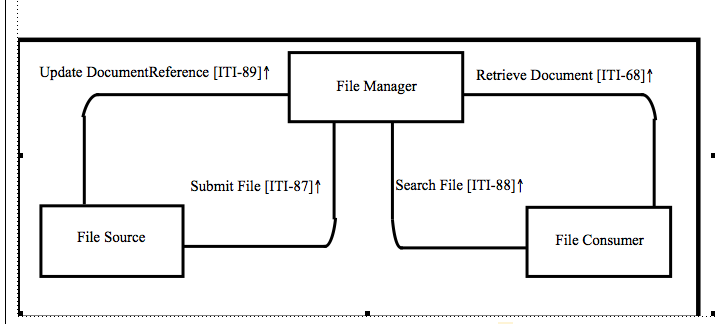Non-patient File Sharing (NPFS)
Non-Patient File Sharing (NPFSm)
Introduction
This supplement defines how to enable the sharing of non-patient files.
Those files can be created, consumed and updated by many different systems involved in a wide variety of data sharing workflows (clinical workflow definition, domain policies sharing, stylesheets management, etc.). This supplement identifies three actors: File Manager, File Consumer, and File Source. To fulfill use-cases requirements, this profile defines three new transactions (Submit File transaction, Search File transaction and Update DocumentReference transaction) and re-uses an MHD transaction: Retrieve Document [ITI-68].
There are IHE Profiles that manage documents that are not patient-related; this profile does not require that the actors be able to process the contents of the files being shared. Understanding this profile does not require the knowledge of the files shared.
The NPFSm Profile specifies transactions for the sharing of files. Any file type can be shared using this profile; however specific guidance is given for three types of files:
- Workflow Definitions: files which define the processing rules for a specific clinical/administrative workflow (see ITI TF-1: 30.4.1.1 “XDW Workflow Architecture” for additional information).
- Privacy Domain Policies: files which describe a specific privacy policy that applies to, or may be agreed by the patient (see ITI TF-1: 19.2 “Creating Patient Privacy Policies” for further details).
- Stylesheets: structured documents used by user-agents (e.g., Web Browsers) to render the content of an XML document.
Local policies may extend the types of files shared using NPFSm and that can be classified using the metadata model described in this profile.
Actors and Transactions
Actors
FileManager
The File Manager stores files provided by the File Source and maintains related metadata. The File Manager responds to search and retrieve requests initiated by the File Consumer. The File Manager responds to metadata update requests initiated by the File Source.
File Consumer
The Authorization Decisions Verifier is the actor that verifies if the Requester Entity is authorized to access specific resources by querying the Authorization Decisions Verifier. This actor enforces the Access The File Consumer queries for file metadata meeting certain criteria, and may retrieve selected files.
File Source
The File Source publishes and updates files produced by either the File Source or by other systems. It is responsible for sending files and related metadata to a File Manager. The File Source can send metadata update requests to the File Manager.
Transactions
Submit File
This transaction allows a File Source to publish one or more new files and related metadata. It also enables update of one or more existing files and metadata by publishing a new version.
This transaction uses the Create File Request message either when there is no prior file, or when the prior needs to be preserved.
This transaction uses the Update File Request message when there is a prior file that doesn’t need to be preserved. (The File Manager is not required to support FHIR resource versioning; see https://www.hl7.org/fhir/STU3/http.html#history.)
Search File
The transaction is used by the File Consumer to find DocumentReference Resources that are stored and managed by a File Manager. Those DocumentReference Resources are not associated with a Patient Resource.
Update DocumentReference File
The File Source uses this message to update just a DocumentReference Resource already stored by the File Manager
Relevant standards
- HL7 FHIR HL7 FHIR standard STU3 http://hl7.org/fhir/STU3/index.html
- RFC2616 Hypertext Transfer Protocol – HTTP/1.1
- RFC7540 Hypertext Transfer Protocol – HTTP/2
- RFC3986 Uniform Resource Identifier (URI): Generic Syntax
- RFC6585 Additional HTTP Status Codes
Use-Case of Reference: Privacy Policies
A hospital’s privacy office defines a set of Privacy Policies that a patient can agree to. Mr. Blue, a hospital privacy office employee, creates the policy file using the HIS. Using a Submit File [ITI-87] transaction, the application makes it available to all the systems involved in his organization.
Mrs. Black, a nurse of the Goodcare Hospital, wants to search for the current valid BPPC Privacy Policy files that the admitting patient can agree to. She uses a combined BPPC Content Creator and NPFSm File Consumer to issue a query, a Search File [ITI-88] transaction, to search for the current valid Privacy Policy files. Once policies are found, she can retrieve them. The retrieved Privacy Policy files are used, by the Content Creator, in the creation of the consent document that the patient can read and agree to.
A legal health officer informs the Goodcare Hospital that one of the Privacy Policy files changed. Mr. Blue searches to discover the Privacy Policy and its related metadata (including FHIR resource ids), once they are found he uses an HIS to perform the Submit File [ITI-87] to update the targeted Privacy Policy and related metadata.

